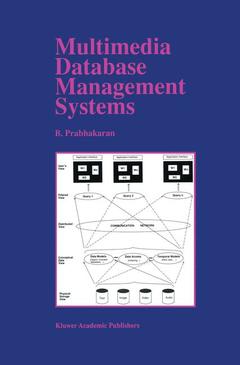Multimedia Database Management Systems, Softcover reprint of the original 1st ed. 1997 The Springer International Series in Engineering and Computer Science Series, Vol. 375
Langue : Anglais
Auteur : Prabhakaran B.

Multimedia Database Management Systems presents the issues and the techniques used in building multimedia database management systems.
Chapter 1 provides an overview of multimedia databases and underlines the new requirements for these applications. Chapter 2 discusses the techniques used for storing and retrieving multimedia objects. Chapter 3 presents the techniques used for generating metadata for various media objects. Chapter 4 examines the mechanisms used for storing the index information needed for accessing different media objects. Chapter 5 analyzes the approaches for modeling media objects, both their temporal and spatial characteristics. Object-oriented approach, with some additional features, has been widely used to model multimedia information. The book discusses two systems that use object-oriented models: OVID (Object Video Information Database) and Jasmine. The models for representing temporal and spatial requirements of media objects are then studied. The book also describes authoring techniques used for specifying temporal and spatial characteristics of multimedia databases. Chapter 6 explains different types of multimedia queries, the methodologies for processing them and the language features for describing them. The features offered by query languages such as SQL/MM (Structured Query Language for Multimedia), PICQUERY+, and Video SQL are also studied. Chapter 7 deals with the communication requirements for multimedia databases. A client accessing multimedia data over computer networks needs to identify a schedule for retrieving various media objects composing the database. The book identifies possible ways for generating a retrieval schedule. Chapter 8 ties together the techniques discussed in the previous chapters by providing a simple architecture of a distributed multimedia database management system.
Multimedia Database Management Systems can be used as a text for graduatestudents and researchers working in the area of multimedia databases. In addition, the book serves as essential reading material for computer professionals who are in (or moving to) the area of multimedia databases.
Chapter 1 provides an overview of multimedia databases and underlines the new requirements for these applications. Chapter 2 discusses the techniques used for storing and retrieving multimedia objects. Chapter 3 presents the techniques used for generating metadata for various media objects. Chapter 4 examines the mechanisms used for storing the index information needed for accessing different media objects. Chapter 5 analyzes the approaches for modeling media objects, both their temporal and spatial characteristics. Object-oriented approach, with some additional features, has been widely used to model multimedia information. The book discusses two systems that use object-oriented models: OVID (Object Video Information Database) and Jasmine. The models for representing temporal and spatial requirements of media objects are then studied. The book also describes authoring techniques used for specifying temporal and spatial characteristics of multimedia databases. Chapter 6 explains different types of multimedia queries, the methodologies for processing them and the language features for describing them. The features offered by query languages such as SQL/MM (Structured Query Language for Multimedia), PICQUERY+, and Video SQL are also studied. Chapter 7 deals with the communication requirements for multimedia databases. A client accessing multimedia data over computer networks needs to identify a schedule for retrieving various media objects composing the database. The book identifies possible ways for generating a retrieval schedule. Chapter 8 ties together the techniques discussed in the previous chapters by providing a simple architecture of a distributed multimedia database management system.
Multimedia Database Management Systems can be used as a text for graduatestudents and researchers working in the area of multimedia databases. In addition, the book serves as essential reading material for computer professionals who are in (or moving to) the area of multimedia databases.
1 Introduction.- 1.1 Types of Multimedia Information.- 1.2 Multimedia Database Applications.- 1.3 Multimedia Objects: Characteristics.- 1.4 Multimedia Database Management System: Components.- 1.5 Concluding Remarks.- 2 Multimedia Storage and Retrieval.- 2.1 Multimedia Object Storage.- 2.2 File Retrieval Structures.- 2.3 Disk Scheduling.- 2.4 Server Admission Control.- 2.5 Concluding Remarks.- 3 Metadata for Multimedia.- 3.1 Metadata: Classification.- 3.2 Metadata for Text.- 3.3 Metadata for Speech.- 3.4 Metadata for Images.- 3.5 Metadata for Video.- 3.6 Concluding Remarks.- 4 Multimedia Data Access.- 4.1 Access to Text Data.- 4.2 Access to Speech Data.- 4.3 Access to Image Data.- 4.4 Access to Video Data.- 4.5 Concluding Remarks.- 5 Multimedia Information Modeling.- 5.1 Object-Oriented Modeling.- 5.2 Temporal Models.- 5.3 Spatial Models.- 5.4 Multimedia Authoring.- 5.5 Concluding Remarks.- 6 Querying Multimedia Databases.- 6.1 Query Processing.- 6.2 Query Languages.- 6.3 Concluding Remarks.- 7 Multimedia Communication.- 7.1 Retrieval Schedule Generation.- 7.2 Multimedia Server-Client Interaction.- 7.3 Network Support for Multimedia Communication.- 7.4 Concluding Remarks.- 8 MMDBMS Architecture.- 8.1 Distributed MMDBMS Architecture.- 8.2 Implementation Considerations.- 8.3 Concluding Remarks.- References.
This book presents the issues and the techniques used in building multimedia database management systems. It discusses two systems that use object-oriented models : OVID (Object Video Information Database) and Jasmine. The models for representing temporal and spatial requirements of media objects are then studied. It also describes authoring techniques used for specifying temporal and spatial characteristics of multimedia databases. The last chapter ties together the techniques discussed in the previous chapters by providing a simple architecture of a disributed multimedia database management system.
Date de parution : 10-2012
Ouvrage de 206 p.
15.5x23.5 cm
Thèmes de Multimedia Database Management Systems :
Mots-clés :
Access; DBMS; communication; composing; computer network; database; database management; information; modeling; multimedia; video
© 2024 LAVOISIER S.A.S.



